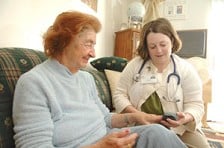Home health-care agencies see rapid growth

.floatimg-left-hort { float:left; } .floatimg-left-caption-hort { float:left; margin-bottom:10px; width:300px; margin-right:10px; clear:left;} .floatimg-left-vert { float:left; margin-top:10px; margin-right:15px; width:200px;} .floatimg-left-caption-vert { float:left; margin-right:10px; margin-bottom:10px; font-size: 12px; width:200px;} .floatimg-right-hort { float:right; margin-top:10px; margin-left:10px; margin-bottom:10px; width: 300px;} .floatimg-right-caption-hort { float:left; margin-right:10px; margin-bottom:10px; width: 300px; font-size: 12px; } .floatimg-right-vert { float:right; margin-top:10px; margin-left:10px; margin-bottom:10px; width: 200px;} .floatimg-right-caption-vert { float:left; margin-right:10px; margin-bottom:10px; width: 200px; font-size: 12px; } .floatimgright-sidebar { float:right; margin-top:10px; margin-left:10px; margin-bottom:10px; width: 200px; border-top-style: double; border-top-color: black; border-bottom-style: double; border-bottom-color: black;} .floatimgright-sidebar p { line-height: 115%; text-indent: 10px; } .floatimgright-sidebar h4 { font-variant:small-caps; } .pullquote { float:right; margin-top:10px; margin-left:10px; margin-bottom:10px; width: 150px; background: url(http://www.dmbusinessdaily.com/DAILY/editorial/extras/closequote.gif) no-repeat bottom right !important ; line-height: 150%; font-size: 125%; border-top: 1px solid; border-bottom: 1px solid;} .floatvidleft { float:left; margin-bottom:10px; width:325px; margin-right:10px; clear:left;} .floatvidright { float:right; margin-bottom:10px; width:325px; margin-right:10px; clear:left;}
Five years ago, Steve Weber and his wife, Kim, launched their own home health-care business with a primary goal of accommodating people in Central Iowa whom no one else was serving.
Their Clive-based agency, Iowa Home Care, now employs approximately 150 full-time-equivalent workers, ranging from registered nurses and licensed practical nurses to home health aides, social workers and a variety of rehabilitation therapy specialists.
“We pretty much offer the whole gamut of any type of care anyone would need coming out of the hospital,” said Steve Weber. He estimates that their business, which has since opened offices in Marshalltown and Boone, has grown by about 50 percent annually. He combined his banking and finance background with his wife’s 15 years of experience in home health care as a registered nurse.
Another home-care agency, At Home Care Co. in Ames, has seen similar growth, driven in large part by increased availability of long-term-care insurance, said its owner and president, Joan Ingwersen.
Now entering her fifth year in business, Ingwersen started the company, which specializes in non-medical home-care services, “because my mother needed help,” she said. “I wasn’t able to find a situation that was perfect for her.” She learned about the business from having worked for a home-care company the family had used in Alabama before moving to Iowa.
“It’s a common thread among many providers,” said Mark Wheeler, executive director of the Iowa Alliance in Home Care, a membership association that represents approximately 170 individual home-care businesses, or about 90 percent of the Medicare-certified home health agencies in the state. “We also have a significant and growing number of members who are non-Medicare-certified,” he said.
As the U.S. population continues to age and more chronic-care services are needed, home health care will need to play an increasingly larger role, Wheeler said.
“Home is a highly desired location in which to receive services,” he said. “AARP surveys bear out that most people would like to remain at home to receive health-care services.”
The home health-care industry is concerned about the potential harm that could occur if federal reform efforts lead to sweeping reductions in Medicare reimbursements, Wheeler said. “I would say the recommendations carry significant, even severe, reductions to reimbursements,” he said. “So health-care reform, if passed, would severely limit home care.”
The Alliance’s focus has been on reducing the level of Medicare cuts proposed in the reform legislation, by emphasizing the value of the home-care services that patients are receiving, as well as its cost effectiveness, he said. Changes to Medicare reimbursement policies by Congress have driven the industry’s peaks and valleys over the years. Ten years ago, when Congress significantly limited reimbursement for home-care services, total employment in the U.S. home health-care industry dipped to about 625,000 people, dropping from more than 700,000 in just two years. It rebounded to more than 900,000 in 2007, according to the latest U.S. Labor Department statistics.
The influx of new agencies was so great that in 2007, Congress acted to limit that growth, placing an effective moratorium on new Medicare-certified agencies, Wheeler said. However, there has been significant growth in non-Medicare-certified agencies that provide cooking, bathing assistance or other non-medical services. Many of those agencies entering the Iowa market are part of large national chains, he said.
More competition is beneficial for everyone, Ingwersen said. “I have found that it’s really good for the consumer to have different choices, because everyone has different needs,” she said. “And every organization seems to have their niche that they do well and that makes them unique.”
Hospital-affiliated home-care agencies also provide significant services in Iowa, and utilization of services is increasing, said Jim Cushing, executive director of performance improvement for Iowa Health Home Care Services, an affiliate of Iowa Health System.
“Folks are taking advantage of new products that are being developed,” Cushing said, among them more advanced wound treatments and technologies. About 30 percent of Iowa Health Home Care patients have some type of wound that needs care, he said. For instance, nurses are using portable electronic technology to send digital images of the wound for evaluation by the patient’s doctor. Additionally, Iowa Health is developing formalized care programs to better coordinate advanced care in the home for conditions such as congestive heart failure.
The home-care industry is now preparing for the likely passage of a 30-day readmissions policy, which would mean Medicare would not reimburse a hospital if a patient is readmitted to the hospital within 30 days of his or her discharge date. Initially proposed only for congestive heart failure readmissions, the policy is now expected to be applied for all causes of readmission.
“It makes home health care much more important and much more used,” said Ruth Coady, executive director of infusion for Iowa Health Home Care. “It will be a collaborative effort (between the home-care agency and the hospital).”
For stand-alone agencies that are not directly affiliated with hospitals, “it’s going to take a deep partnership,” Cushing said. “Those (agencies) who are able to collaborate most effectively with the hospitals to prevent readmissions, those are going to be the most successful.”
The Iowa Alliance in Home Care offers free resources to assist families in choosing home health-care services. For more information, visit www.iowahomecare.org.








